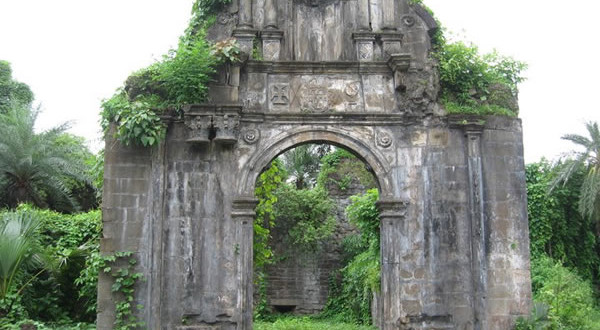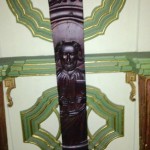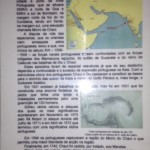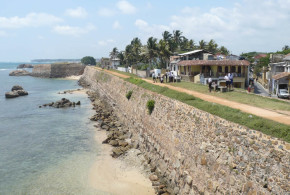Written by Marco Ramerini. English text revision by Dietrich Köster.
If you know something on colonial remains or if you have photos of such remains – they may be anywhere in the world -, send them to me. I’ll be happy to publish them on this website. Thank you. Marco. My e-mail is on the home page.
PORTUGUESE COLONIAL REMAINS
ASIA
BAHRAIN
Manama (Bahrain Island): Remains of Qal’ At Al-Bahrain (16th century) or Portuguese Fort. The fort consists of three huge strongholds and the remnants of two towers in the middle and full walls linking the three strongholds together. It is surrounded by a trench. It lies on the northern coast of the island, in the most western point of an open gulf close to the city of Manama.
Muharraq island: Abu Mahir Fort or Qal’at Abu Mahir (16th century): a little fort on the southwest side of Muharraq island. Portuguese Fort, Qal’at Arad (16th century): beautifully restored Portuguese Fort. It takes the shape of a square fort, and in each corner there is a control tower. The fort is surrounded by a fortification which is a trench fed with water through a well dug in the middle of the trench.
BANGLADESH
Portuguese surnames
BURMA
People of Portuguese descent called “Bayingys”, they are Catholics and still live scattered in 13 villages in Sagaing Division in Upper Burma.
Syriam: ruins of Portuguese fort and church.
INDIA
Portuguese Creole language (Korlai, Damão, Diu, Goa). Eurasian Community, Portuguese surnames, religion.
Goa: language, Eurasian Community, Portuguese surnames, religion. Velha Goa: Cathedral or Sé Catedral de Santa Caterina (1562), Igreja and Convento de São Francisco de Assis (1661), Capela de Santa Caterina (1552), Igreja and Convento de São Caetano (1655-1661), Arco do Vice-Rei, Basílica do Bom Jesus (1594-1605), Igreja de Nossa Senhora do Rosário (1544-1549), Church and Convent of Santa Monica (1606-1627), ruins of Augustinian Church and Monastery (1602), Church of Cruz dos Milagres (1671), ruins of Church and College of St. Paul (1541-1543). Sinquerim (Goa): Church of Sao Lourenço (1630). Talaulim (Goa): Church of Santa Ana (1695). Curtorim (Goa): Church of St. Alex (1597). Betim (Goa): Reis Magos Church (1771). Chapora (Goa): fort (1617). Mapusa (Goa): Church of Our Lady of Miracles (1674). Aldona (Goa): Church of St. Thomas (1596). Moira (Goa): Igreja de Nossa Senhora da Imaculada Conceição (1636). Panjim (Goa): Historic town, Igreja da Imaculada Conceição (1600s). Aguada (Goa): Fort Aguada (1604 -1612). Reis Magos (Goa): Fort Reis Magos. Tiracol (Goa): Fort Tiracol (1745). Cabo da (de) Rama (South Goa): Fort Cabo de Rama (1763). The Cabo de Rama Fort includes a small church of Santo António in excellent condition. Dona Paula (Goa): Cabo Fort, Cabo Palace.
For this info my thanks to Kiros Kokkas.
Famous colonial houses of Goa: Chandor (Goa): Menezes–Bragança house, Pereira-Bragança house, Sara Fernandes house. Loutolim (Goa): Miranda house, Salvador Costa house, Roque Caetan Miranda house, Figueiredo de Albuquerque house (3 kms north of Loutolim). Majorda (Goa): Piedade Costa house. Betalbatim (Goa): Wilfrido Antão house. Cansaulim-Velsão (Goa): Roldão de Souza house (also Maison Rodesa). Margão (Goa): The house of the Seven Gables and many houses around the Chuch of Espírito Santo (Largo da Igreja). The (usually locked) Igreja Nossa Senhora da Piedade stands on a hill overlooking Margão. Corjuem (North Goa): Fort. Alorna (North Goa): Fort. Candolim (North Goa): Casa dos Monteiros, Casa dos Costa-Frias. Calangute (North Goa): Casa da Proença, Casa Bragança. Pernem (North Goa): Deshprabhu house (or Sitaram Vilas, or The Viscount’s Palace).
For these info my thanks to Kiros Kokkas.
Anjediva island (Kanara): ruins of Fort de Nossa Senhora das Brotas, old Portuguese “caserma” or barracks, standing now without the roof, Igreja de Nossa Senhora das Brotas 1729).
For this info my thanks to António Vazquez.
Diu: fortress (1535), forte do Mar or Panikot, Igreja de São Paulo (1610), Igreja de São Thomé, Igreja de São Francisco de Assis, Old Hospital, several chapels, language.
For this info my thanks to António Vazquez.
Simbor (25 Km. East of Diu): Forte de Santo António de Simbor.
For this info my thanks to António Vazquez.
Damão: The Damanganga River divides the town in Small (“Nani”) and Big (“Moti”) Damão. There is a Portuguese fort on each side of the estuary. Forte de São Jerónimos (or Nani Daman Fort) has an impressive arched entrance and the Igreja de Nossa Senhora do Mar inside. Moti Daman Fort. It is much bigger than the Forte de São Jerónimos, with more robust walls and stands on the opposite bank of the river. Inside there are the Catedral da Sé (Bom Jesus), the Igreja de Nossa Senhora do Rosário and in the western part of the fort are found the ruins of a Dominican monastery. In the center of Nani Daman town (the part of the town north to the Damanganga), on the Seaface Road stands a Portuguese covered Mercado Municipal.
For this info my thanks to Kiros Kokkas.
Dadrá: Portuguese church: Missão de São Francisco.
For this info my thanks to António Vazquez.
Silvassa (Nagar Haveli): Portuguese church: Igreja de Nossa Senhora da Piedade.
For this info my thanks to António Vazquez.
Dahanu: fort Chinchani (near Tarapur): traces of a bastion.
Tarapur: fort, Portuguese Coat of Arms and inscription dated 1593.
Mahim: fort, well preserved.
Quelme (Kelve): a few ruins of the fort with a bastion.
Ilhas das Vacas (Arnala): fort, well preserved.
Baçaim (Vasai): fortified town ruins, town walls (1550-1582) with 10 bastions well preserved (ruins of : Nossa Senhora da Vida (1535), Igreja Igreja Franciscana and Convento de Santo António, Augustinian Church and Convent, Jesuits Church and Convent (1561), Church and Convent of the Dominicans, Igreja Matriz de São José (1546), Câmara, Senado, Chapel of St. John Baptist), Forte de São Sebastião (1536-1539). The Jesuit Church is currently (1/2007) under renovation and will soon be the first complete church of Bassein. (There is a lot of confusion about the names of the ruined churches among the local population)
Dharavi: ruins of the fort.
Montpezir (Salsette island, near Bombay): ruins of a Jesuit Monastery (16th century) ?.
Thana (near Bombay): St John Baptist church, situated north of Masunda Talav (popularly known as Talav Pali ). The church has a big bell (72 feet high), which is believed to be the largest bell amongst the remaining Portuguese churches in the country. There is also a huge cross on the church, which has on its four corners the years inscribed AD 1609 & AD 1775. Fort ?
Bandora (Bandra): St. Andrew’s church, it’s a church with Portuguese-style facade.
Caranja (Karanja): a few ruins of the fort.
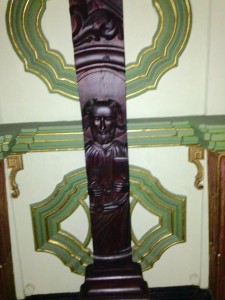
A piece of a wooden door of Chaul (India) in the Military Museum of Lisbon. This piece presents a low relief of St Peter. Author and Copyright Pierre Moreira.
Chaul (Revdanda): fortified town ruins, town walls (1571-1582) (ruins of: Igreja Matriz, Augustinian’s Church and Convent, Franciscan’s Church).
Korlai: Morro fortress, language (in Korlai), Portuguese church (Korlai).
Cannanore: Forte de Santo Ângelo (1505).
Cochin: The so-called “Dutch Palace” in Mattanchery was originally built by the Portuguese as a gift to the Raja of Cochin. The Dutch made subsequent additions. No traces of the old walls around Cochin remain. Original Portuguese churches stand in: Mattanchery: N.S. da Vida ( built before 1560, repairs 1596-1605) with some Manuelino style traits. Mattanchery: Chapel of Holy Cross (1550). Edocochin: São Lourenço (1504, at 10 kms south of Cochin). Vypeen Island: N.S. da Esperança (1503, repairs in 1596-1605) with a façade in pure Manuelino style, probably the only such building in India. All of them are in excellent condition. All other Portuguese churches in Cochin, including St. Francis and the Sé Catedral Santa Cruz, have been rebuilt and are not the original constructions. An octagonal, three storey-high Portuguese fort in excellent condition (Forte Manuel) stands in Pallipuram (North Vypeen Island, 10 kms from Cochin). It is the first European building in India from 1503.
For this info my thanks to Kiros Kokkas.
Quilon: ruins of Thangasseri fort, Portuguese/Dutch cemetery.
Kanniyakumari: Church.
Manapad: Holy Cross Church (1581).
Kottar (Nagercoil): St.Xavier Church, it dates back to the 16th century dedicated to St.Francis Xavier.
Mylapore/Meliapor (a seaside suburb a few kms south of the centre of Madras): Nossa Senhora do Rosário built in 1635, in Kutcheri Road near the St. Thomas Cathedral (inside the Franciscan Mission compound, opposite the Diocese building, also visible from the street). On 156 Luz Church Road (the westward extension of Kutcheri Road) is the Igreja de Nossa Senhora da Luz (Our Lady of Light, locally pronounced “Laz Church”). It is thought to be the oldest Portuguese church in Madras, built in 1516. Its founding is associated with a miracle: Portuguese sailors in difficulties at sea were once guided to land by a light, which when they tried to find its source, disappeared. The church dedicated to Nossa Senhora da Luz was erected, where the light left them. It is also locally known as the ‘Kaatu kovil’ (Church located in a forest). The 19th century (1896) neo-gothic Cathedral of Saint Thomas was built by the British on the exact site of the much smaller Portuguese church dedicated to the same saint. The Portuguese church, which in turn had replaced an older Nestorian Christian church, was built in 1523 over the tomb of St. Thomas; his relics are kept inside. It is a major pilgrimage site. St. Francis Xavier is said to have lived some time there in an attached building.
For this info my thanks to Kiros Kokkas.
St. Thomas Mount (11 kms south of Madras, near the Madras airport): On the top of this hill is the church of Nossa Senhora da Esperança (Our Lady of Expectation), built by the Portuguese in 1523/1547, presently (2007) under renovation. It has the Portuguese royal coat of arms over its entrance and a wonderful retábulo behind the altar (which marks the spot St. Thomas was killed). A painting of the Madonna and Child, also in the church, is credited to St. Luke. Inside the church St. Thomas’ Cross is said to have bled in 1588 and 1704. The church is reached by 134 steps marked at intervals with the fourteen stations of the Cross. At the beginning of the steps, at the northern foot of the Mount is a gateway of four impressive arches surmounted by a cross bearing the inscribed date 1547.
For this info my thanks to Kiros Kokkas.
Little Mount (8 kms south from the centre of Madras): Near the modern, circular Church of Our Lady of Good Health is the older Blessed Sacrament Chapel built by the Portuguese near the cave, which is believed to be the place, where in AD 72 the mortally wounded St. Thomas sought refuge. Behind the church of Our Lady of Good Health is a natural spring. A legend says that it was created, when St. Thomas struck the rock, thus the crowds, who came to hear him preach could drink. Little Mount has an ancient church (Resurrection) built by the Portuguese in 1551. At the entrance is a portrait of St. Thomas and a Portuguese inscription. Halfway up the hill a shrine was constructed by the Portuguese in 1711. Of this old Church the chapel – the Blessed Sacrament Chapel – still stands intact.
For this info my thanks to Kiros Kokkas.
Madras: Portuguese Church of St. Assumption (1600/1640/1850).
Pulicat: Church of Our Lady of Glory (1515).
Diamond Harbour (48 Km. from Calcutta): ruins of a Portuguese fort ???
Bandel (near Calcutta): Portuguese monastery relics
- A piece of a wooden door of Chaul (India) in the Military Museum of Lisbon. This piece presents a low relief of St Peter. Author and Copyright Pierre Moreira.
- Caption (in Portuguese) depicting this piece. Military Museum of Lisbon. Author and Copyright Pierre Moreira
INDONESIA
Portuguese surnames, religion.
Kota Ambon (Ambon): remains of fort Victoria (Nossa Senhora da Anunciada 1575), Tombstone of “Capitão-mor” Sancho de Vasconcelos ?. Hitu (Ambon): foundation remains of Portuguese Fort ? A large Catholic population testifies the Portuguese legacy. Bandaneira (Banda): foundation ruins of Portuguese fort (now called Nassau) (1529). One of the few Portuguese reminders is the metal ceremonial hat (shaped like the Iberian soldier’s helmet of the 16th century) worn during the kora kora war canoe races.
For this info my thanks to Glenn Sundeen.
Lohajong, Lewohajon or Lewohajong (Solor): ruins of the Portuguese/Dutch fort and several cannons. Ternate: ruins of Fort Kayuh Merah, ruins of Fort Kastella or Gammalamma (Nuestra Señora del Rosario) a Portuguese/Spanish fort, fort’s ruins. Tidore: Tahula: Spanish fort’s ruins. Rum: Spanish fort’s ruins. Matjan (Moluccas): Ruins of a Portuguese fort in Tabilolo (east part of the island).
For this info my thanks to Londoh.
Halmahera: there are reports of a small Tobelo clan called “Moro” who are considered to be of Portuguese descent. Sidangoli: ruins of the old Portuguese/Dutch fort. Gamhoku (near Tobelo): foundations of Portuguese fort (Difficult to see). Jailolo: ruins of Portuguese/Spanish fort and canon in front of the Mesjid.
For this info my thanks to Londoh.
Malbufa: ruins of a Portuguese (?) fort. Pulau Ende (Ende Menor, island just off the town of Ende, Flores): The visible remains of the fort appear to be just one ‘turret’ of about three or four meters diameter and very overgrown.
For this info my thanks to Brian Whitmey.
Nggela (80 km from Ende): There is an old Portuguese cannon.
Larantuka (Flores): “Topasses” community, Confraternity of “Reinja Rosari”, there are old Portuguese bronze and silver known as “Ornamento” in the chapel Tuan Maria, an old Portuguese font and a cannon. The Portuguese legacy is found in people’s names and rituals.
Sikka (Flores): In the Sikka area, there is a pocket of Portuguese cultural influence, which thrives to this day. The dance named Taja Bobu performed by Portuguese settlers in the area 400 years ago is still performed today. Many of the people of Sikka are descendants from the Portuguese and still ??? use that language. In the area there is also a large monastery and a hospital (in Lela 4 Km. from Sikka) established by the Portuguese. (according to an essay by Douglas Myers “Outside influences on the music of Nusa Tenggara Timur”)
Vurek (Adonara): Portuguese church bell of Vure with a Portuguese inscription (1714), Confraternity of “Irman”, Portuguese fort ?.
Namata (Sawu): There is a stone with a carving of a four-mast sailing ship. Though the writing beneath has faded, villagers say this was drawn by the Portuguese in 1864 ? 1684 ?.
Kwandang (Sulawesi): ruins of fort Ota Mas Udangan (Dutch or Portuguese?), ruins of fort Oranje (Dutch or Portuguese?)
Gorontalo / Dembe hill (Sulawesi): ruins of fort Otanaha: remains of three towers (Dutch or Portuguese?).
Kema (Sulawesi, Manado): Portuguese graves ?.
Jakarta (Java): In the Museums there are: a Portuguese “Padrão” (National Museum) the so called Luso-Sundanese padrão (1522). A Portuguese church bell (1633) (National Museum), a Portuguese-Malacca cannon (Kota Museum).]
IRAN
Hormuz: a substantial part of the Portuguese fort still exists, its walls and towers, although damaged, are still impressive, in particular the underground water cisterns.
Qeshm: ruins of the fort.
MACAU
Portuguese language, Portuguese Creole language, Eurasian Community, Portuguese surnames, religion.
Macau: ruins of São Paulo’s church (1602), Citadel of São Paulo do Monte (17th c.), Portas do Cerco (barrier gate) (1573), Guia Fortress (1637), Leal Senado (Municipal Council), São Domingos church (17th century), São Tiago Fortress (17th c.), Luís de Camões Museum building (1770), church of São Lourenço, Igreja de Santo Agostinho, Seminário and Igreja de São José.
Coloane: São Francisco Xavier Chapel.
MALAYSIA
Portuguese Creole language Kristang (Malacca), Eurasian Community, Portuguese surnames, religion.
Malacca: ruins of fortress “A Famosa” “Porta de Santiago” (1511), ruins of St. Paul’s church (1521)with several Portuguese tombstones, Kristang language, Eurasian community (Portuguese settlements), in the St. Peter’s church is a bell in the belfry dated 1608 and manufactured in Goa, India, which was taken from one of the churches, which was burnt by the Dutch. St. Peter’s Church, erected by the Portuguese community (1710), this church has similarities to the contemporary Portuguese architecture in Goa. It is a Portuguese building of the Dutch period in Malacca.
MALDIVES
Hithadhoo island: On the northern end of this large fertile island (second most populous in the Maldives), is a pile of stones called the old Portuguese fort. The immediate area around the stones is called Kotte.
For this info my thanks to Michael O’Shea.
OMAN
Muscat: Fort Jalali (1580s), Fort Mirani (1580s).
Mutrah: Fort Mutrah (1580s).
Al Hazm: Portuguese cannons.
Bandar al Jissar (15 kms S.E. of Muscat): Ruins of a small tower presumably built by the Portuguese to deter Ottoman Turks from landing in Oman.
For this info my thanks to Kiros Kokkas.
Barka: Fort (Portuguese ?).
Bukha (Musandam peninsula): 16th century fort built by the Portuguese (?)
Khasab (Musandam peninsula): fort and round Tower (1623).
Sohar: Fort (Portuguese ?).
SAUDI ARABIA
Tarut island: Tarut fort (16th. c.): a beautiful Portuguese (?) fort.
SRI LANKA
Portuguese Creole language, Eurasian community (Portuguese Burghers), Portuguese surnames (Perera, Silva, Pieris) and Portuguse personal names (Pransisku=Francisco, Peduru=Pedro, Juvan=Joao), Religion (Roman Catholicism), Music (baila), Portuguese titles (Sinno, Dona, Dom), dresses, food.
Batticaloa: Portuguese/Dutch Fort (1628).
Galle: the Portuguese were the first to build a circular fort around the city. The Dutch rebuilt it (and it saved the city from the 2004 tsunami!). From the present structure the Zwart Bastion (Black Bastion, on the northeast point, inside the military compound, off limits to civilians) is thought to be Portuguese-built and is the oldest of the Fort Bastions.
For these info my thanks to Kiros Kokkas.
Jaffna: The small Dutch church in the centre the fort was destroyed during the civil war. The fort itself is left intact (occupied by military, off limits).
For these info my thanks to Kiros Kokkas.
Kalpitya (50 kms from Puttalam, West Sri Lanka, on the peninsula opposite to it): a Portuguese church in very good condition near the market with a few Dutch and English tombstones in its floor. Adjacent is a small European cemetery. Nearby lies a square fort in excellent condition, overlooking the seashore (occupied by the military and therefore off limits). It was used by the Dutch, but possibly is of Portuguese origin. In the middle of the above-mentioned peninsula in Talawila is the Church of Saint Ann, which was originally built by the Portuguese in the 16th century. The present day church was built in late 19th century and has a statue of Jesus and a wooden crucifix both from Portugal. It is an important pilgrimage site and great festivals are held in March and July.
For these info my thanks to Kiros Kokkas.
Mannar Island: A star-shaped Portuguese-Dutch fort (occupied by military, off limits).
For these info my thanks to Kiros Kokkas.
Negombo: The Dutch fort of Negombo is practically a reduction of the much greater Portuguese fort, which existed in the same area. Today only the main gate and a (much younger) Clock Tower remain.
For these info my thanks to Kiros Kokkas.
Ratnapura: Portuguese Stone Slab, Church.
For these info my thanks to Kiros Kokkas.
Sellankandal(10 km inland from Puttalam): A Portuguese regiment of soldiers from Mozambique settled in the village of Sellankandal sometime in the 17th century. As late as the 1930s villagers spoke a Portuguese dialect. Today people of mixed African descent live in the area.
For these info my thanks to Kiros Kokkas.
Trincomale: Portuguese/Dutch (1624).
*Velani (Kayts Islands): ruins of a Fort. *Delft Island: ruins of a Fort.
*Chankanai (Jaffna Peninsula): ruins of a Portuguese Church (1641).
*Myliddi (Jaffna Peninsula): ruins of a Portuguese Church.
*Vaddukoddai (Jaffna Peninsula): ruins of a Portuguese Church.
*Atchuveli (Jaffna Peninsula): ruins of a Portuguese Church.
*Karisal (Mannar): ruins of a Portuguese Church.
* The civil war between Singhalese and Tamil seems to have destroyed many of the above-mentioned monuments.
THAILAND
There is still a very small Portuguese community in Bangkok, who descended down from the Ayuthaya period. Most of them married into Thai families and changed their surnames to Thai ones, but some still use Portuguese. Such families are ‘Na Silawan’ (da Silva), ‘Yesu’ (de Jesus), ‘Renangkul’ (de Reina) and so on. In Thailand there are also remains of an old (ruined) palace of a Prime Minister in Lopburi, which was built by Portuguese free soldiers around the 1670s.
For this info my thanks to Pathorn Srikaranonda.
There is/was a nearly assimilated community of Portuguese Thai in Pattanni, southern Thailand. In 1973 they were distinguishable solely by physical characteristics and some unique surnames. Within a generation or two they will thoroughly merged into the larger Thai gene pool. Their language now is completely Thai, Pattanni Malay, and trade Chinese. The legend is that they are the remains of a community left behind, when the Portuguese abandoned their trading post at Pattanni.
For this info my thanks to Philip Abbey.
Ayuthya: Campo Português.
TIMOR LESTE
Portuguese language, Eurasian Community (Mestiços or Topasses), Portuguese surnames. churches, forts, buildings, religion.
Ainaro: A big church. Baguia: A fort from 1915. Balibo: A big fort on the top of the hill at the end of the city, with low walls, well preserved. Locked. Batugade: A small, 1655, fort in the entrance of the village, with low walls, well preserved, used by the military. Usually locked. Baucau: A huge, albeit abandoned, Mercado Municipal in the centre of the city. Dili: the mid-20th century churches of Motael and Balide. The Liceu Dr. Francisco Machado in downtown. The deep-red Casa da Cultura de Timor by the seaside in front of the Portuguese embassy, dates from the late 19th century. The former governor’s palace (newly wonderfully restored) 5 kms to the south of the centre, on the way to Maubisse. The beautifully restored, but locked, Mercado Municipal. Laga: An old, crumbling Portuguese fort, with two round towers. Laleia: A beautiful, pale pink church with two bell towers. Lautem: The easternmost fort of the Portuguese empire stands at the Baucau-side entrance of the town. Tall walls with a small tower. Not very well preserved, full of thorn bushes. Manatuto: An ochre-painted church in traditional Portuguese style. Maubara: A big fort by the seaside next to the main highway, with low walls in good condition with a few cannons. It is inhabited by a policeman-guard, who is the only person, who has the keys. If he is gone, there is no way to see the interior. Maubisse: an old Portuguese castle used to stand on the hilltop, where the “Pousada de Maubisse” guesthouse now stands. There is very little left of the original structure (lower part of the walls). Venilale: The elegant “Escola do Reino de Venilale” is newly restored and painted in lively colours. Oecussi enclave: Pantemakassar: Fatusuba castle overlooks the town. Well preserved with massive walls and a few buildings inside.
For these info my thanks to Kiros Kokkas.
UNITED ARAB EMIRATES
Dibba Hisn (Doba): ruins of the fort (Portuguese?)
Badiyah (Libedia?): ruins (poorly preserved remains) of the Portuguese fort recently excavated by an Australian expedition.
Kalba: Portuguese fort restored recently.
Khor Fakkan (Corfacao): fort (Portuguese?)
OCEANIA
AUSTRALIA
Bittangabee Bay (south of Eden on the southern coast of New South Wales, in the Kanangra-Boyd National Park): There are the remains of an old stone structure. There are ruined walls of about 33mx33m built from rough boulders, and the remains of a smaller internal building built from worked stone. Above the lintel on what was a gateway to this inner blockhouse is carved the date 15?4. the third figure is worn away but if it was a 2 then it would tie in with the (?) presence (?) in that area of Cristovao de Mendonca’s caravels. IS IT PORTUGUESE ?
Bittangabee Bay photos.
For this info my thanks to Bob Hay.
 Colonial Voyage The website dedicated to the Colonial History
Colonial Voyage The website dedicated to the Colonial History
